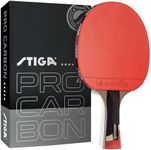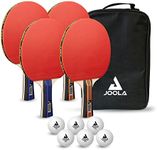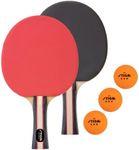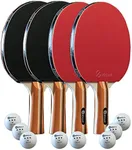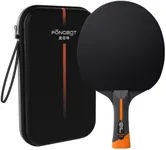Buying Guide for the Best Table Tennis Paddles
Choosing the right table tennis paddle can significantly impact your game. Whether you're a beginner or an advanced player, understanding the key specifications of a paddle will help you make an informed decision. The right paddle should complement your playing style and skill level, enhancing your performance and enjoyment of the game.BladeThe blade is the main part of the paddle and is usually made of wood or composite materials. It affects the speed and control of your shots. Blades can be categorized into three main types: all-round, offensive, and defensive. All-round blades offer a balance of speed and control, making them suitable for beginners. Offensive blades are faster and suited for aggressive players who prioritize speed and power. Defensive blades provide more control and are ideal for players who focus on precision and spin. Choose a blade that matches your playing style and skill level.
RubberThe rubber on the paddle's surface influences the spin and speed of the ball. There are two main types of rubber: pips-in and pips-out. Pips-in rubber provides more spin and control, making it suitable for players who rely on spin and precision. Pips-out rubber offers less spin but more speed, ideal for players who prefer fast, flat shots. Additionally, the thickness of the rubber affects performance; thicker rubber increases speed, while thinner rubber enhances control. Select a rubber type and thickness that aligns with your playing strategy.
HandleThe handle of the paddle comes in different shapes and sizes, affecting your grip and comfort. Common handle types include flared, straight, and anatomical. Flared handles are wider at the end, providing a secure grip and are popular among players. Straight handles are uniform in width and allow for easy switching between forehand and backhand grips. Anatomical handles are contoured to fit the shape of your hand, offering a comfortable and ergonomic grip. Choose a handle that feels comfortable in your hand and suits your grip style.
WeightThe weight of the paddle affects your control and speed. Lighter paddles (around 70-85 grams) offer better control and are easier to maneuver, making them suitable for beginners and defensive players. Heavier paddles (90-100 grams) provide more power and speed, favored by offensive players who rely on strong, fast shots. Consider your playing style and physical strength when choosing the weight of your paddle.
SpeedSpeed refers to how fast the ball travels when hit with the paddle. Paddles with higher speed ratings are designed for aggressive, offensive play, allowing for powerful shots. Lower speed ratings provide more control, making them suitable for defensive or all-round players. Assess your playing style and whether you prioritize speed or control to determine the appropriate speed rating for your paddle.
ControlControl is the paddle's ability to accurately place the ball where you want it. Paddles with higher control ratings are easier to handle and provide better precision, ideal for beginners and defensive players. Lower control ratings are typically found in paddles designed for speed and power, suitable for advanced players who can manage the reduced control. Evaluate your skill level and playing style to choose a paddle with the right balance of control.
SpinSpin is the paddle's ability to impart rotation on the ball. Higher spin ratings are beneficial for players who use spin to dominate their opponents, allowing for more varied and strategic shots. Lower spin ratings are found in paddles that prioritize speed and flat shots. Consider how much you rely on spin in your game and select a paddle that matches your spin needs.
